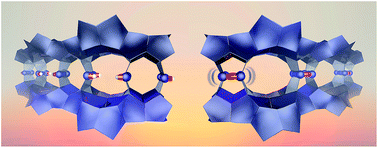Flexibility versus rigidity: what determines the stability of zeolite frameworks? A case study†
Abstract
All silica COK-14/-COK-14 with OKO topology is the first case of a zeolite which reversibly transforms from a systematically interrupted to a fully connected state and back. Analysis of the opening/closing behavior allowed the study of entropy and framework flexibility as determinants for the stability of zeolite topologies, which, until now, has been experimentally inaccessible. Interconversion of the all-silica COK-14 zeolite with fully connected OKO topology and its -COK-14 variant with systematic framework interruption was investigated using high-temperature XRD, thermogravimetric analysis, 29Si MAS NMR, nitrogen adsorption and a range of modelling techniques. Specific framework bonds in the OKO framework can be reversibly hydrolyzed and condensed. Structural silanols of the parent -COK-14, prepared by degermanation of the IM-12 zeolite, were condensed by heating at 923 K, and hydrolyzed again to the initial state by contacting the zeolite with warm water. Molecular modelling revealed an inversion of the relative stabilities for both variants depending on temperature and hydration. Condensation of the structural silanols in -COK-14 to COK-14 is entropy driven, mainly resulting from the release of water molecules. Framework reopening in the presence of water is spontaneous due to the high rigidity of the fully connected OKO framework. Isomorphous substitution was demonstrated as a viable option for stabilization of the fully connected OKO framework as this renders the closed framework flexible.


 Please wait while we load your content...
Please wait while we load your content...